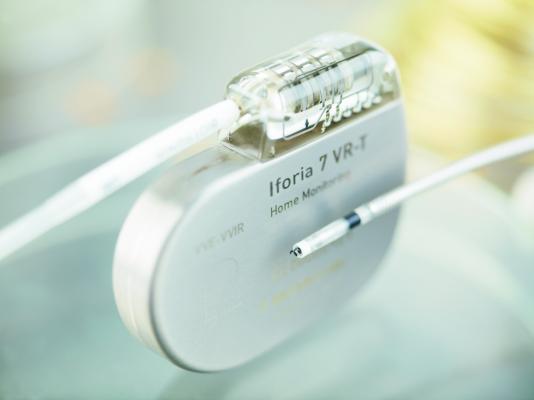
The FDA has concerns about the cybersecurity of implantable medical devices with wireless connections for patient monitoring or adjustments to how the device functions. Changing the function of an implantable cardioverter defibrillator (ICD) using wireless access to the device could present a major patient safety issue.
As wearable and implantable patient monitoring or therapy devices become more sophisticated with advanced wireless connectivity to extract patient information and change the device functionality, there are growing concerns these technologies will be be targets of hackers. The U.S. Food and Drug Administration (FDA) believes this poses a threat to patient safety. The agency announced this week the availability of the guidance document entitled "Postmarket Management of Cybersecurity in Medical Devices."
The FDA is issuing this guidance to inform industry and FDA staff of the agency's recommendations for managing postmarket cybersecurity vulnerabilities for marketed medical devices. The guidance clarifies FDA's postmarket recommendations with regards to addressing cybersecurity vulnerabilities and emphasizes that manufacturers should monitor, identify, and address cybersecurity vulnerabilities and exploits as part of the postmarket management of their medical devices.
The issue of cybersecurity of cardiac implantable devices raised concerns with the Secret Service with former vice president Dick Cheney, who had one of these devices. The issue was also raised in 2016 by a medical device market research firm that published a report alleging these vulnerabilities exist in St. Jude Medical's implantable electrophysiology (EP) devices. Read the article "Market Report Calls Into Question St. Jude Medical EP Device Safety, Cybersecurity."
Background on the FDA Cybersecurity Guidance
On Feb. 19, 2013, the President issued Executive Order 13636 - Improving Critical Infrastructure Cybersecurity, which recognized that resilient infrastructure is essential to preserving national security, economic stability, and public health and safety in the United States. Executive Order 13636 states that cyber threats to national security are among the most serious and that stakeholders must enhance the cybersecurity and resilience of critical infrastructure. This includes
the healthcare and public health critical infrastructure sector.
The FDA also said Presidential Policy Directive 21 - Critical Infrastructure Security and Resilience (PPD-21), issued on Feb. 13, 2013, tasks federal agencies to strengthen the security and resilience of critical infrastructure against physical and cyber threats such that these efforts reduce vulnerabilities, minimize consequences, and identify and disrupt threats. PPD-21 encourages all public and private stakeholders to share responsibility in achieving these outcomes.
In recognition of the shared responsibility for cybersecurity, the security industry has established resources including standards, guidelines, best practices and frameworks for stakeholders to adopt a culture of cybersecurity risk management. Best practices include collaboratively assessing cybersecurity intelligence information for risks to device functionality and clinical risk. FDA believes that, in alignment with Executive Order 13636 and PPD-21, public and private stakeholders should collaborate to leverage available resources and tools to establish a common understanding that assesses risks for identified vulnerabilities in medical devices among the information technology community, healthcare delivery organizations, the clinical user community, and the medical device community. These collaborations can lead to the consistent assessment and mitigation of cybersecurity threats, and their impact on medical device safety and effectiveness, ultimately reducing potential risk of patient harm.
Guidance Document Details
Part 806 (21 CFR part 806) requires device manufacturers or importers to report promptly to FDA certain actions concerning device corrections and removals. However, the majority of actions taken by manufacturers to address cybersecurity vulnerabilities and exploits, referred to as "cybersecurity routine updates and patches," are generally considered to be a type of device enhancement for which the FDA does not require advance notification or reporting under part 806.
For a small subset of actions taken by manufacturers to correct device cybersecurity vulnerabilities and exploits that may pose a risk to health, the FDA would require medical device manufacturers to notify the agency.
This guidance clarifies changes to devices to be considered cybersecurity routine updates and patches (e.g., certain actions to maintain a controlled risk to health). In addition, the guidance outlines circumstances in which FDA does not intend to enforce reporting requirements under part 806 for specific vulnerabilities with uncontrolled risk. Specifically, FDA does not intend to enforce the reporting requirements when circumstances outlined in the guidance are met within the predefined periods of time (e.g., communicate vulnerability to customers and user community and propose a timeline for remediation within 30 days after learning of the vulnerability; fix the vulnerability and validate the change within 60 days after learning of the vulnerability; actively participate in an Information Sharing Analysis Organization (ISAO)). The agency considers voluntary participation in an Information ISAO a critical component of a medical device manufacturer's comprehensive proactive approach to management of postmarket cybersecurity threats and vulnerabilities and a significant step towards assuring the ongoing safety and effectiveness of marketed medical devices.
Public Comments on the Guidance Document
The public can submit comments via the Federal eRulemaking Portal at www.regulations.gov. All comments will be made public.















